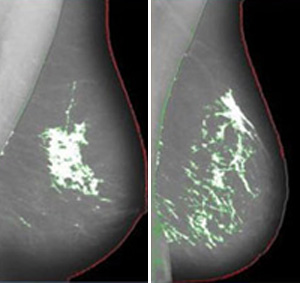Can Features on a Mammogram Be Used to Help Determine a Woman's Risk of Breast Cancer?
Researchers in the Mayo Mammography Health Study are investigating whether features on mammograms might help clarify the risk of developing breast cancer in the years after a mammogram.
The features of interest reflect variations in the amount and location of dense breast tissue versus fatty breast tissue. These variations are seen as differences in the light and dark regions on the mammogram image.
Under the direction of Dr. Vachon, the mammography research team also is reviewing how these features might change with age and therapy.
Two features on mammogram images that researchers are examining for their importance in future breast cancer are:
- Breast density
- Patterns of breast density
Breast density
Dense tissue variation
Dense tissue variation

Dense tissue variation
These images show breasts with different amounts of dense tissue on the mammograms. The mammogram on the right shows a fatty breast, and the mammogram on the left shows a dense breast.
Breast density percentage
Breast density percentage

Breast density percentage
These images use computerized algorithm (cumulus) for estimating percent of breast density. The red line notes the outline of the breast, and the green line notes the outline of dense tissue.
Breast density is the term used to describe the variation in dense tissue on a mammogram image.
Fatty breast tissue is radiologically more translucent than is dense (fibroglandular) breast tissue.
This means that regions of a breast that comprise fatty tissue will appear darker on a mammogram image and regions that comprise mainly dense tissue appear whiter.
Breast density can be classified in many ways, including the overall amount or proportion of dense tissue on the mammogram.
The Mayo Mammography Health Study uses the clinical density measure, the American College of Radiology Breast Imaging Reporting and Data System (BI-RADS) Atlas density, and computerized measures to assess the percentage of density.
Dr. Vachon and her mammography research team have shown that for the same age and weight, women with increased breast density have a higher risk of developing breast cancer.
Related publications:
Patterns of density
Breast density variations
Breast density variations

Breast density variations
Here, pictures of mammograms with similar percent densities show different patterns and variation of breast density.
The amount or percent of dense tissue on a mammogram may not be the only aspect of the mammogram that provides information about a woman's future breast cancer risk.
Patterns of density may also play a role in breast cancer risk.
Two breasts can have the same percent of density, but the dense tissue is distributed in different patterns throughout the breast.
For example, some breasts might show a central area or cluster of dense tissue, while others have several areas of dense tissue scattered throughout the breasts.
Research conducted in the Mayo Mammography Health Study has shown that the variant in the tissue on the mammogram also is a risk factor for breast cancer.
Related publications: